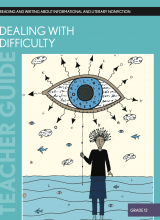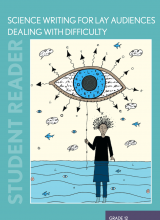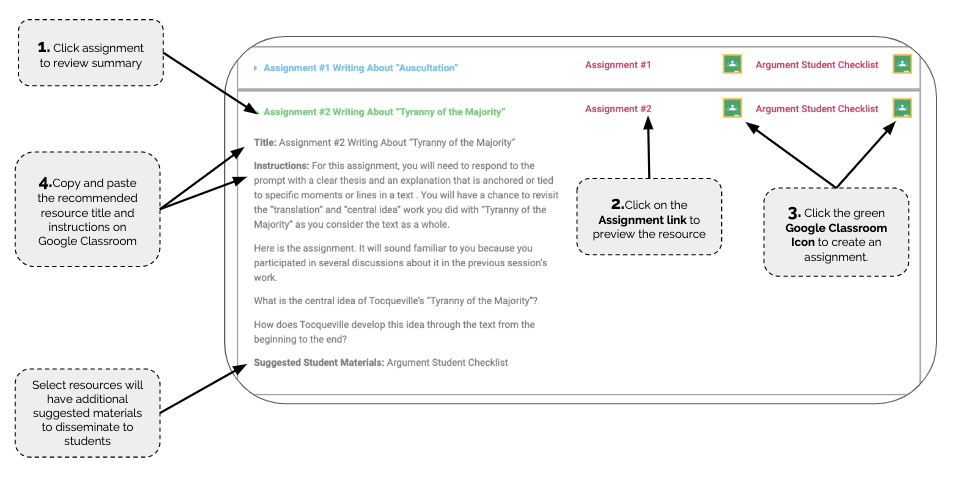Dealing With Difficulty - Grade 12
The Dealing With Difficulty series was conceived as part of Inquiry By Design’s efforts to ensure that secondary students have regular and supported opportunities to work with difficult texts. Each unit at each grade level is an excursion into difficulty that is important in and of itself, but that is also valuable because it supplies a basis for reflection and comparison in subsequent experiences with difficult texts.


Table of Contents
Writing Tasks
Title: Small-Groups: Central Message in “Of Idleness”
Teacher Manual Instructions:
Session 4
After students have finished their quick writes, place them in pairs or trios.
Distribute the assignment and ask students to work with their partners to create a chart (or charts, if members of the groups disagree about the message Montaigne is sending). Tell the class that each chart should include the following information:
1. A brief answer to the question “What is the central message Montaigne is sending in ‘Of Idleness’?”
2. Summaries or excerpts of the lines or moments from the text that support that position and show how he develops this message.
Remind students to draw on their quick writes, their notes, and the “Retelling ‘Of Idleness’” chart to do this work. Students are welcome to incorporate drawings or other visual representations in their chart to help convey their ideas, if it is helpful to them.
Use this time to confer with groups about the task.
Title: Writing About “Of Idleness”
Instructions:
For this assignment, you will need to respond to the prompt with a clear thesis and an explanation that is anchored or tied to specific moments or lines in a text . Remember, this is not new work for you. You have had a lot of experience doing interpretive work in both discussion and writing and have practiced chunking and translating this text with your peers.
Here is the assignment. It will sound familiar to you because you participated in several discussions about it in the previous session’s work.
Explain Montaigne’s central message in his essay “Of Idleness,” analyzing how he develops this idea over the course of the text.
Suggested Student Materials: Informational_Explanatory Checklist
Title: Writing About “Politics and the English Language”
Instructions:
For this assignment, you will have a chance to work across Orwell’s whole text as you attempt to explain in detail the central claim of his essay.
Here is the assignment. Part of it will sound familiar to you because you have already dis- cussed this idea in small groups and as a whole class.
At the end of his essay, Orwell writes that “the present political chaos is connected with the decay of language and that one can probably bring about some improvement by starting at the verbal end.”
Explain the connection Orwell makes between “political chaos” and the “decay of language” and then summarize his case for why “starting at the verbal end” might make things better.
Suggested Student Materials: Informational_Explanatory Checklist
Charts for Discussion
Title: Difficulty in “Of Idleness” What and Why?
Teacher Manual Instructions:
Session 1
Next, sketch out a two-column chart like the one nearby and ask students to create one like it in their notebooks. Students may recognize the similarity of this chart to the work from Science Writing for Lay Audiences, though there will be some differences in the workflow in this unit.
- Give students 3-4 minutes to review the text and the moments they marked as difficult. Encourage them to add any additional markings to the text during this review.
- Afterwards, reconvene the class and ask students to share the moments they identified as difficult. Work with the class to enter line numbers and excerpts in the chart’s first column and to answer the “Why is it difficult?” question in column two. As before, when working on the second column, push students to explain what, specifically, makes the moment confusing or difficult. Sometimes, that explanation will simply be “I don’t know this word,” but other times they will need to clarify further: “This sentence is so long I can’t untangle what he’s talking about,” for example, or “I don’t understand how he is trying to use these quotations from other sources.”
Title: Translating Section #1
Teacher Manual Instructions:
Session 1
As a whole class, craft a translation of this first part of the text that clarifies the meaning of, and the relationships between, the ideas Montaigne sequences. Remind students, once again, that you are only focusing on the section of the text up to the phrase “proper for our service.”
Note: Remember that the point of the translation work isn’t to get the text perfect the first time, but rather to model for students how to do this kind of close reading of difficult historical texts.
Capture the retelling of this portion of the text on a chart titled “Translating Section #1.”
Title: Translating Section #2
Teacher Manual Instructions:
Session 2
Reconvene the whole class and work as a group to craft a translation of the portion of the text between the first semicolon and the first colon. Students should compare this to their own translation; consider asking students to copy the class translation down as a model, especially if the class translation differs meaningfully in content from individual groups’ work.
Capture this on a chart titled “Translating Section #2.”
Title: Translating Section X
Teacher Manual Instructions:
Session 3
Reconvene the whole class.
Move through the remainder of the text, one section at a time, by asking a few groups to share their translations of that one section.
Use this sharing as a starting point to negotiate a whole-class translation of each section.
Capture each translation on a chart labeled with the section number (e.g. “Translating Section X”).
Afterwards, revisit the following question to debrief the translation experience:
“What did are the things you did to create a translation, and what was the order, as best you can remember, in which you did them?”
- Note: Again, ask students to explain specifically how they solved the difficulties they marked. Different difficulties are likely to be solved in different ways, and it is worth adding these specifically.
- Add any new items to the “Translation Strategies” chart.
Title: Retelling “Of Idleness”
Teacher Manual Instructions:
Session 4
Work with the whole class to create a retelling of the entire essay.
Note: Inquiry By Design distinguishes between retellings and summaries or other types of similar responses. A retelling, in this sense, typically presents a fairly straightforward, point-by-point version of the text (“First it says this, then it says this…”) and is not usually anchored by an overarching “main idea,” as a summary would be.
There is a place for each in instruction and we provide guidance for teaching summary writing in the Form guide; however, the purpose of the retelling at this point is to scaffold the upcoming work with Montaigne’s main idea.
As they collaborate on the retelling, remind students to draw on the information and insights they garnered from the signpost work and the translation of each section.
Capture the class’s translation on a new chart titled “Retelling ‘Of Idleness.’”
Title: Difficulty in “Politics and the English Language” What and Why?
Teacher Manual Instructions:
Session 6
Sketch out a two-column chart titled “Difficulty in ‘Politics and
the English Language’: What and Why?” like the one below and ask students
to create one like it in their notebooks. Remind students that they completed this same type of chart with the Montaigne essay and review any instructions or improvements you would like to see students make in the way they approach this task the second time. (For example, you might wish to see more specific descriptions of why something was difficult.)
Give students 1-2 minutes to review the text and the moments they marked as difficult. Encourage them to add any additional markings to the text during this review.
Next, reconvene the class and ask students to share the moments they identified as difficult. Work with the class to enter line numbers and excerpts in the chart’s first column and to answer the “Why is it difficult?” question in column two.
Title: Orwell’s Introduction: A Translation
Teacher Manual Instructions:
Session 6
Reconvene the whole group and work with the class to craft a translation of the first section. Capture this translation on a chart and title it something like “Orwell’s Introduction: A Translation.” Students should compare this to their own translation. Consider asking students to copy the class translation down as a model, especially if the class translation differs meaningfully in content from individual groups’ work.
Checks for Understanding
Title: Translation Strategies
Teacher Manual Instructions:
Session 1
Read through the translation of the first section of text one last time, making any refinements students suggest.
Wrap up the session by using the following question to debrief the work period experience:
“What are the things you did to create a translation, and what was the order, as best you can remember, in which you did them?”
Check for understanding: Capture student observations on a chart titled “Translation Strategies.”
Title: Chunk #2: A Translation
Teacher Manual Instructions:
Session 7
Convene a whole-class discussion about the translation work. During this conversation, be sure to capture the class’s thinking on a new chart titled “Chunk #2: A Translation” that can be displayed for the whole class to see. This conversation is a chance for the class to notice overlaps across groups and to benefit from the thinking each group did.
Title: Chunk #3: A Translation
Teacher Manual Instructions:
Session 8
Draw on the students’ work to negotiate a whole-class translation and capture it on a chart titled “Chunk #3: A Translation.” Again, students should compare this to their own translation and update theirs if they come to a new understanding of the passage.
Title: Chunk #4: A Translation
Teacher Manual Instructions:
Session 9
Draw on the students’ work to negotiate a whole-class translation and capture it on a chart titled “Chunk #4: A Translation.” Again, students should compare this to their own translation and update theirs if they come to a new understanding of the passage.
Title: Key Ideas About Political Chaos and the Decay of Language
Teacher Manual Instructions:
Session 10
In addition to facilitating this conversation, work hard to capture and distill the major ideas that students are developing on a chart titled “Key Ideas About Political Chaos and the Decay of Language.” Push students to help you build text-based explanations to support them. This will ensure that students get a glimpse of what it looks like when someone builds a text-based explanation.
Independent Reading
Title: Book Interview
Instructions:
Display a copy of the “Book Interview” sheet for the class to see and distribute copies to students.
Using one of the books from the classroom library, model for students how to interview a book and how to fill out the sheet. Answer any questions students have about the form and its terminology.
Give students time to interview three books and to enter their findings on the “Book Interview” sheet.
Title: Book Pass
Instructions:
Organize students’ desks into a circle (or, if this is not possible, determine a very clear path for books to pass through the group).
Explain the purpose of a book pass:
A book pass is another way to expose students to the texts available in the classroom library. A book pass requires students to use their book interviewing skills. A book pass is a chance for students to find titles to add to their “Books I’d Like to Read” list.
Display a copy of the “Book Pass” for the class to see and pass out copies to students.
Demonstrate for the class how a person goes about making an entry on the form. Since students will need to write quickly, show how an author can be listed just by last name and first initial, and demonstrate how a student can abbreviate a long title if necessary. What matters is that they have enough information to track down the book again later if they need to.
Give each student one book (or magazine). Tell them it doesn’t matter which text they start with, because they will see all—or at least many of—the books. (Be sure you have one title for each student in the circle.)
Choose a direction for passing.
After students receive a book, they should immediately record the author’s name (if the text is a book) and title on the “Book Pass” form.
Give students one minute to interview each book following the procedure established in the previous session.
At the end of one minute, call “pass.” At this time, students should make an entry in the comments column and pass the book to the next student.
Continue the book pass until each student has interviewed all the books.
Title: Book Recommendation
Instructions:
Distribute copies of the “Book Recommendation” form to students and give them time to craft or begin crafting their first review. Students can choose to write about a book they’ve completed recently or one they remember well from past reading.
Title: Goals for My Reading Life
Instructions:
Display a copy of “Goals for My Reading Life” for the class to see and distribute copies to students.
Use this time to review how to fill out the goals sheet. Be sure to show students how they can use the charts to generate ideas for answers to the “Goals” questions.
Take a moment to stress the value and function of the “Books I’d Like to Read” list. Point out that this list is a tool that serves the same function as a bedside table for some readers: It is a place to store up titles or books that are “next in line.” Remind the class that readers constantly have their eyes open for “next” texts. A “Books I’d Like to Read List” is a way to prevent aimless and unproductive castings around for new reading materials. It’s a planning tool.
Explain that at the beginning of each marking period, each student will fill out a new goals sheet; at at the end of each marking period, students will take a few minutes to review their goals statements and reflect on their efforts to meet them.
Answer any questions students have about the “Goals for My Reading Life” forms.
Give students time to complete the form and set a deadline for submission. You may decide to photocopy these to keep a set for yourself. Return the forms to students during the next session and have them attach the form to a page in their notebook or save it for their student portfolio (see Creating a Student Portfolio).
Title: Reading Log
Teacher Manual Instructions:
Show students how to set up a “Reading Log” in their notebook. They should be sure to enter it in their table of contents. You may decide to distribute sticky notes so that students can flag this page. Use the model on the next page to guide your efforts.
Notice the column titled “Date Completed/# of Pages Read.” This column is a place for students to record, and receive credit for, the reading of texts that did not require a “cover-to-cover” experience. Be sure to point out that reading sections of several texts for specific purposes is not the same as skipping aimlessly from book to book to book. The former often indicates purposefulness and interest; the latter can indicate confusion or disengagement.
After students have set up the reading log—including proper headings, creating the grid, etc.—demonstrate how to make an entry.
Answer any questions students have about the log.
Remind students that the reading log is a tool to be used in conjunction with the “Goals” sheets. Students track their reading in the log and then use the log to evaluate their progress toward their goals.
If you plan to use student portfolios this year, consider introducing them at this time using some version of the information in the section that follows. Review Creating a Student Portfolio in advance to be sure you have thought through some of the important questions for portfolio work.
Unit Resources
Title: Writing About “Politics and the English Language”
Title: Grades 11 and 12 – Informational_Explanatory Rubric
Title: Scaffolds and Modifications: Descriptions and Use
